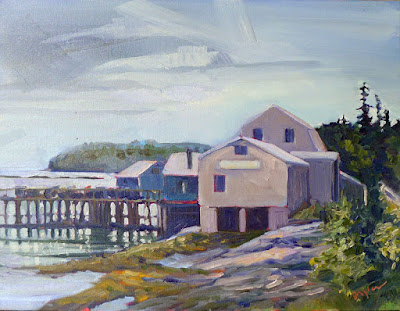The first glorious plein air painting day was our last class of the spring session. It was grand.
 |
| Camden and Mt. Battie, by Carol L. Douglas |
Nobody understands spring like a Northerner. We long for that giddy day when the temperature first climbs above 50° F., the rain stops, and the sky clears. Our joints cease their muttering, our backs straighten, and our steps grow firmer and quick. It is a privilege to watch ice and snow roll back from the tomb of winter.
I used to teach every week. I travel too much for that now, so I break my classes into six-week sessions. This one has been shut indoors too much of the time by frankly lousy weather. It’s frustrated me. I think of myself as an apostle of plein airpainting. How am I going to spread the good word, caged in my studio like that? Yesterday was expected to be cool with possible showers. It ended up being wonderful.
 |
| Great clouds and a rolling river. |
The Megunticook is still raging down its chute into Camden harbor. A sky of sublime beauty sailed around us. Cumulus clouds formed above Mt. Battie and to the east over Penobscot Bay. Cirrus clouds striped the high altitudes. The wooden boats for which Camden is justly famous rocked gently at their moorings, their owners hard at work preparing for the season. The deep blue of the sky reflected midnight in the harbor waters. There were great paintings everywhere, and we were present.
I like most of my students, but this group has been special. Two absolute beginners drove in every week from near Jay. That may be only a distance of sixty miles or so, but, for you flatlanders, it takes the better part of two hours. That’s commitment.
 |
| Dinghy, Camden Harbor, by Carol L. Douglas |
Only one student has been with me before. The other three are pretty advanced painters. All of them have great potential.
“That froth is not white,” I pontificated. Then I suggested they use pale tints of lavender and yellow ochre to model it.
“I believe you, but I don’t see it,” Jennifer answered. That comes with time, I told her.
 |
| A spectacular pileup of clouds to the east. |
They may be done with this session, but still I gave them one last homework assignment: to look at
Joaquin Sorolla’shandling of white. They are a myriad of tints, but I’ve noticed no absolute white anywhere.
I think commercially-bottled water is a lousy deal, environmentally and personally. Still, my house (like yours) always seems to collect the darn stuff. I’ve been toying with a bottle in my studio recently. It’s multifaceted and infinitely reflective. That led to my students’ second assignment: to draw a water bottle, in all its whirling complexity. If the drawing conveys meaning or mood, that’s even better. These students have until the end of the month to finish. You, dear reader, can
email yoursto me any time you want.
 |
| Your homework assignment, should you choose to accept it. Draw this, but do it from life, not from a photo. |
Alas, the morning sped by, and we parted. By teatime, Mt. Battie and Camden were again shrouded in rain. We’d had a brief window of perfect weather and we had gloried in it.
Our new session starts Tuesday, May 30 and runs for six classes, skipping merrily over Independence Day. I’ll give you more information soon, but you can
read about it or register here.




























